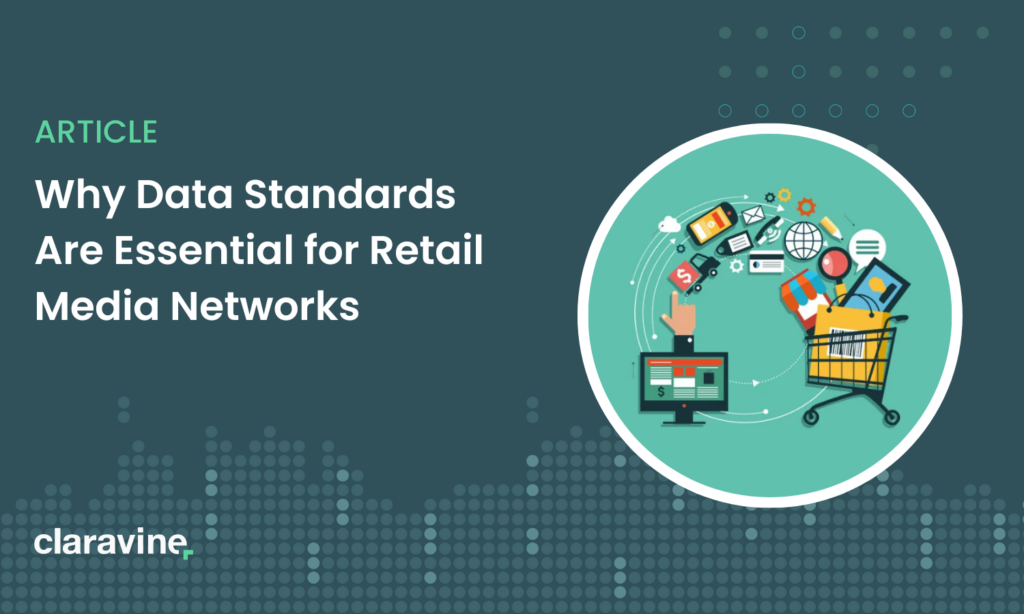Why Data Standards Are Essential for Retail Media Networks

Forward-thinking retailers have discovered a valuable opportunity hiding in plain sight: their own digital properties and first-party customer data. By transforming websites, apps, and purchase histories into advertising platforms, they’re developing additional revenue streams that complement their core business.
While traditional retail focuses on product sales, advertising allows retailers to monetize their digital traffic and customer relationships in new ways — creating value from every visitor interaction, whether or not it results in an immediate purchase.
These retail media networks (RMNs) are exploding: according to eMarketer, they were projected to capture one-fifth of worldwide digital ad spend in 2024, raking in $140 billion.
With more than 200 RMNs now in the market, the landscape has expanded far beyond traditional retailers like Amazon and Walmart, from banking to travel to real estate: Chase, United Airlines, Marriott, and Re/Max have launched their own advertising platforms.
As this competition intensifies, simply having first-party data isn’t enough to stake a claim. To attract advertisers and their budgets, RMNs need to provide unified, transparent data that can demonstrate ROI across increasingly complex advertising environments.
This is where data standards — the structured approach to organizing and managing marketing metadata — become the critical foundation for sustainable revenue.
Advertisers demand better data and greater reach
As retail media matures, so do advertisers’ expectations. To stay competitive, even smaller RMNs now need to provide advanced reporting, expanded reach, and precise targeting.
Accurate, reliable data and reporting
Better measurement is at the top of most advertisers’ wishlists for RMNs. According to Skai’s 2025 State of Retail Media report, consumer goods marketing leaders would be most likely to increase RMN investment if they received improved insights and measurement innovations.
Retailers that cannot provide accurate, consistent measurement risk losing advertising dollars to competitors who can demonstrate clear value.
Audience precision and personalization
While on-site advertising (promoting products on an owned website) provides valuable access to in-market shoppers, retailers can expand their reach with audience extension ads. This off-site advertising leverages the retailer’s first-party data to target consumer groups with relevant ads across the broader web.
In 2025, 62% of advertisers plan to increase their off-site spending — a 21% increase from the prior year. Especially for smaller retailers who don’t have Amazon or Walmart’s massive on-site traffic, this presents a meaningful opportunity to drive revenue.
Audience extension also offers an opportunity to tap into additional advertising budgets beyond trade and shopper marketing — but only if the audience targeting, enhanced personalization, and closed-loop measurement justifies the cost.
However, off-site advertising only multiplies the RMN’s data challenges. Each external platform (like Meta, TradeDesk, or other publisher networks) has unique interfaces, metrics, and reporting structures that must be reconciled into coherent campaign views.
Easier said than done, and nearly impossible without advanced, automated data management.
Audience extension through off-site advertising
While on-site advertising (promoting products on an owned website) provides valuable access to in-market shoppers, retailers can expand their reach with audience extension ads. This off-site advertising leverages the retailer’s first-party data to target consumer groups with relevant ads across the broader web.
In 2025, 62% of advertisers plan to increase their off-site spending — a 21% increase from the prior year. Especially for smaller retailers who don’t have Amazon or Walmart’s massive on-site traffic, this presents a meaningful opportunity to drive revenue.
Audience extension also offers an opportunity to tap into additional advertising budgets beyond trade and shopper marketing — but only if the audience targeting, enhanced personalization, and closed-loop measurement justifies the cost.
However, off-site advertising only multiplies the RMN’s data challenges. Each external platform (like Meta, TradeDesk, or other publisher networks) has unique interfaces, metrics, and reporting structures that must be reconciled into coherent campaign views.
Easier said than done, and nearly impossible without advanced, automated data management.
RMNs need to overcome data challenges to deliver
The truth is, for many RMNs, campaign management and reporting haven’t matured to the level advertisers expect.
Instead, retailers rely on a maze of spreadsheets and manual processes. Account managers manually download audience segments, upload them to various platforms, then individually collect performance data across systems before attempting to clean data and create coherent reports.
According to Forrester senior analyst Nikhil Lai, “Each RMN has tons of advertisers, so when media management is manual, it creates a lot of low-level labor that could be better spent on capabilities such as analytics.”
These manual processes create significant data management challenges: preventing timely and unified reporting, undermining personalization, and complicating audience extension.
Siloed data prevents unified reporting
With campaign data scattered across multiple platforms and spreadsheets, creating the unified reporting that advertisers demand becomes a pipe dream. Reconciling performance data requires extensive manual intervention — especially when different account managers or teams use inconsistent naming conventions for campaigns, audiences, and creative assets.
Without centralized, standardized data, networks can’t efficiently answer basic questions like: “How did this campaign perform across all channels?” or “Which audience segments drove the highest conversion rates?”
This doesn’t fly with advertisers, who cite concerns about data accuracy (44%) and extensibility (43%) as their top challenges to measuring incrementality in retail media — a critical metric for proving ROI.
Product and inventory data disconnects hurt campaign performance
Beyond campaign data silos, many RMNs struggle with disconnected product and inventory information. When advertising systems operate separately from supply chain and inventory management, campaigns continue promoting products that are out of stock, hotel rooms that are full, or flights that are overbooked.
This disconnect creates poor customer experiences and directly impacts ROI. Advertisers pay for clicks and impressions that can’t convert because the promoted products simply aren’t available. For commerce media networks in particular, where ads are directly tied to specific inventory, these data silos can significantly undermine campaign effectiveness and advertiser confidence.
Fragmented data makes personalization unscalable
The sophisticated audience precision that advertisers demand requires meticulously managed data. But when product categories, customer segments, and campaign elements are named or organized inconsistently, maintaining granular audience segments becomes unmanageably complex.
If RMNs can’t clearly understand the connections between customers, it isn’t possible to create targeted audience segments and serve them with tailored ads.
Inconsistent metadata complicates audience extension
When extending audiences to external platforms, inconsistent metadata creates significant complications. If audience segments are defined differently across platforms or campaigns lack standardized naming conventions, it becomes difficult to track which audiences are exposed to which messages across which channels.
This data fragmentation directly undermines off-site advertising capabilities and hampers RMNs’ ability to drive revenue.
At the heart of each of these challenges lies the same fundamental issue: a lack of consistent data standards that can bring order to the increasingly complex world of retail media.
Key components of effective RMN data standards
Data standards help address all of these challenges — and meet these opportunities — by applying consistent marketing metadata at scale for retail media networks. Practically, that looks like:
-
- Campaign naming conventions: A standardized — and automatically enforced — approach to naming campaigns ensures consistency across platforms and enables automated reporting.
- Cross-channel audience definition consistency: When audience segments are defined consistently across channels, retailers can provide accurate reach and frequency reporting.
- Creative asset management: Standard tagging conventions enable retailers to track which creative elements perform best across campaigns.
- Platform integration standards: Establishing standard processes for metadata flowing between the retail media network and advertising platforms ensures consistent implementation.
- Agnostic data environment: A neutral data platform that facilitates secure data sharing with advertisers and media partners — while maintaining governance and without creating dependencies on specific vendor ecosystems.
As Jim Warner, Global Field CTO for Retail at Snowflake explains, “Effective retail media networks need a central, cloud-based data platform that can seamlessly connect disparate data sources while maintaining data governance and security. This allows retailers to unify campaign data without creating new silos, and future-proofs retail media data as their tech stack evolves.”
By implementing these data standards, retailers can transform their data from a management headache into a competitive advantage — a particularly critical shift as the market enters its next phase.
The standards-driven future of retail media
The gold rush heyday of RMNs may already be waning.
As analyst Eric Seufert tells Modern Retail, “There’s a limit to how many of these the market can support, and we might be approaching that.” According to eMarketer, more than half of US advertisers say they’re willing to work with a maximum of four retail data partners.
Investing in an organized, structured approach to data enrichment helps retailers stay ahead of the curve. Implementing proper data standards today puts an RMN in a better position to scale efficiently, attract premium advertisers, tap into larger advertising budgets, and compete effectively against larger players.
Ready to discover how data standards can power your retail media network? Talk to our team to learn more.


